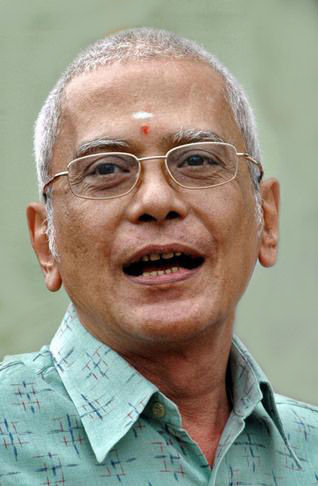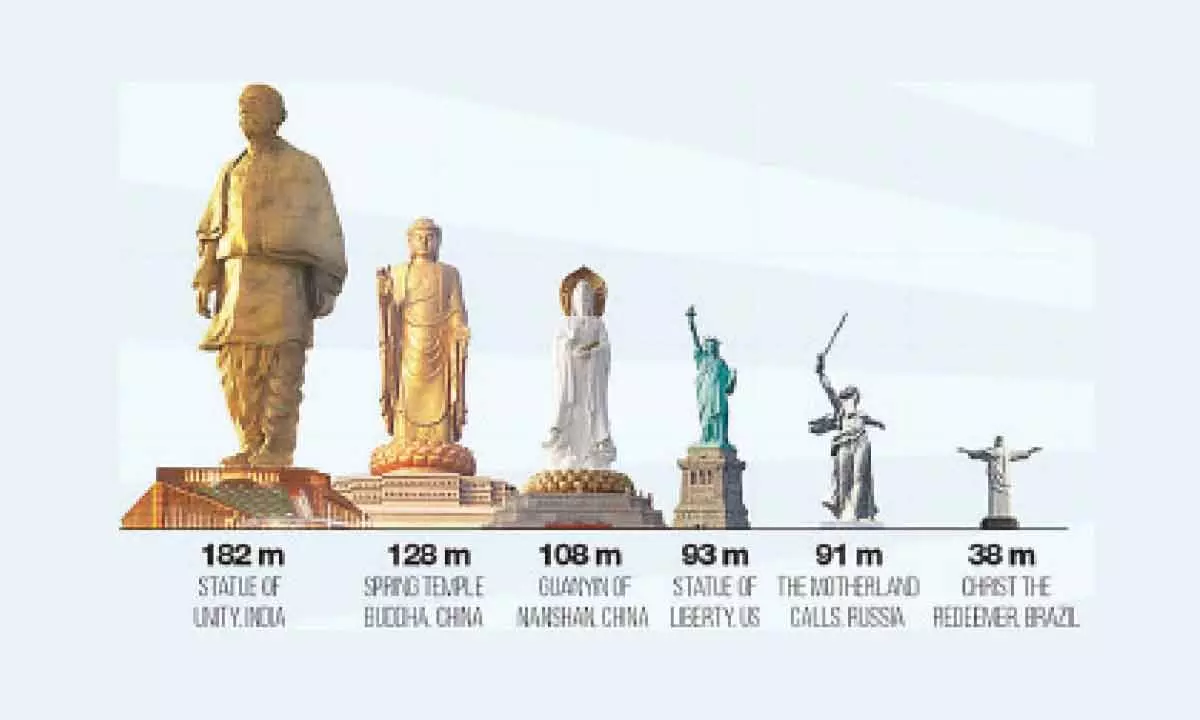Live
- ‘Santhana Prapthirasthu’: A family delight
- ‘Dilruba’ poster released, valentine’s release
- Aija Premier League Season 9: Grand Finale Celebrates Local Cricket Talent
- Hindu Dharma Padayatra Gains Support at Erravalli Crossroads.
- Sithara Entertainments announces ‘An Unfinished Story’
- Vishwaksen’s stunning female look revealed
- Sharwa’s ‘Nari Nari Naduma Murari’ First Look Revealed
- Sankranti Cricket Tournament Fosters Unity and Sportsmanship in Maldakal
- Prabhas unveils new poster for ‘The Raja Saab’
- Congress Leaders Discuss Installation of Iconic Sculptures with Renowned Sculptor Ram V. Sutar
Just In
Symbols of honour, worship and ardour


Statues have, for long, been symbols of the history of a culture and serve the purpose of memorialising and adulating the lives and times of great people. Erection of statues is a fixation at least 400 centuries old. From the word ‘statue’ is derived the expression ‘statusque,’ meaning graceful or dignified
The saying that history is written by the victors is often attributed to Sir Winston Churchill, the legendary Prime Minister of England, during the Second World War. It is an indisputable fact that the chronicling of the events that constitute the history of a race, religion, cult, or nation is primarily a subjective exercise. Much of the choice, of the events and the manner in which they are described, depends on the point of view of the historian. As in the case of ethics and morals, perception of heroism and villainy varies over time and geography. What is good, today, may not be so a few decades later. Likewise, what is acceptable in one religion may be taboo in another, at the same time, and within the same region. The concepts of right and wrong also similarly vary from place to place. For example, General Dyer, the architect of the unspeakably inhuman massacre of innocent people in Jallianwala Bagh in Amritsar, Punjab, was upon his return to England not seen as a villain but welcomed as a hero. In fact, the British newspaper, ‘Morning Post,’ carried an article titled, ‘For General Dyer, the man who saved India,’ which, ironically enough, received massive response, resulting in donations amounting to £26,000, enough for Dyer to live in comfort for the rest of his life. I remember standing next to the statue, on a visit to London, and marvelling at the character of a nation that can celebrate the memory of such a person.
Statues have, for long, been symbols of the history of a culture and serve the purpose of memorialising and adulating the lives and times of great people. Erection of statues is a fixation at least 400 centuries old. From the word ‘statue’ is derived the expression ‘statusque,’ meaning graceful or dignified.
One of the most enduring memories, from my childhood, is that of the statue of Sir Thomas Munro in (then) Madras, now Chennai. Sir Thomas was a Scottish soldier, served as the Governor of the then Madras State, and was famously known for the introduction of the system of direct collection of land revenue from individual cultivators through government agents.
I have since encountered many statues, of eminent heroes, and heroines, of the past. For long, the statues, of Gautama Buddha in the Hussain Sagar Lake, of Mahatma Gandhi outside the State Legislature building, or Rajiv Gandhi in Somajiguda and of Dr Ambedkar at the entrance to the Tank Bund across the Hussain Sagar lake, were among the most prominent ones in this twin cities of Hyderabad and Secunderabad. Recent entrants to the list are NTR’s statue on the Hyderabad-Srisailam Road, the Statue of Equality, of the Indian philosopher Ramanuja, on the outskirts of Hyderabad, (the second tallest sitting statue in the world), and statue of Dr Ambedkar in the newly built Telangana state secretariat building, which is said to be the tallest statue of Ambedkar in the country.
Venus de Milo, one of the most popular artefacts on display at the Louvre in Paris, is a marble statue of a Greek goddess, created around 100 BCE and one of the best preserved Greek statues in existence.
There is as much to be said in favour of the culture of erecting statues as there is against it. It has been pointed out that statues do not just fail to teach us about the past, merely or give a misleading idea about particular people or historical events, but also skew our understanding of history. It is not unknown for governments to resort to the questionable act of rewriting history in order to suit their political purposes. Consequently, a whole generation of people can be led into developing a totally different appreciation of the events of the past. Heroes can be portrayed as villains and vice versa. Likewise, venues of horrendous crimes can become glorified locations treated with veneration.
Many statues, in India and elsewhere in the world, have been subjects of controversy. In 1776, a statue of King George III at Bowling Green in Manhattan, New York City, was torn down by patriots rebelling against what they viewed as a symbol of British oppression. Ironically, the pieces of the statue were later melted down into more than 42,000 bullets, referred to as Melted Majesty, and used to fight the British, during the revolutionary war.
The Vietnam Veterans Memorial, also called The Wall National Monument, in Washington was intended to honour members of the US armed forces who had served and died in the Vietnam War. On it were inscribed the names of about 58,000 men, and women, killed or missing in action. The design was selected in a competition sponsored by the Vietnam Veteran’s Memorial Fund. It, however, generated considerable opposition, on the ground that it was in sharp contrast to the traditional format for a memorial. Thankfully, a compromise was subsequently reached and the memorial commissioned.
The Statue of Unity, a monument recently erected to in memory of Sardar Vallabhbhai Patel, on the banks of the Narmada river and close to this Sardar Sarovar Dam, near Vadodara city in Gujarat has, similarly, caused a mixed reaction. Critics have pointed out that the location is in an ecologically sensitive zone with geological fault lines. It is also very near the Shoolpaneshwar sanctuary and the construction activity can damage the ecologically sensitive area. Those who welcome erection of the statue, however, point out that the monument is an ode to the ‘Iron Man’ of India, who was responsible for unifying the 562 erstwhile princely states. The statue is also expected to boost income from tourism and encourage the coming up of a large number of hotels as well as transport and other services. At 240 meters, the Statue of Unity on the banks of the Narmada river near the city of Vadodara in Gujarat is claimed to be the tallest statue in the world.
The limestone Buddha statue in Abhaya Mudhra at Nelakondapalli in Khammam district of Telangana was created in the 3rd century CE, during the rule of the Ikshvaku Dynasty. It was unearthed during an excavation in 1977. The statue is now getting ready for its journey to join as an exhibit in the Early Buddhist Art exhibition, at the Met in New York.
Modern Indian sculpture artists blend traditional styles with western creative ideals. Beautiful ancient sculptures adorn palaces, temples and caves in India. But distinct from them are modern Indian sculptors who have conjured outstanding avant-garde creations based on western principles.
The title, ‘Father of Modern Indian Sculpture’ must go to Ramkinkar Baij (1906-1980), a prolific artist who utilised a wide variety of materials to create many types of forms, and experimented with minimalism and geometric abstraction. He was a maverick, who believed in his own guts, and proved to be flamboyant, yet noble, in his manoeuvres. Shilpa Gupta is another contemporary Indian artist, who lives and works in Mumbai. The Statue of Unity was designed by Ram Vanji Sutar from Maharashtra.
When we look at the whole world, Michelangelo was an Italian sculptor, painter, architect, and poet of the High Renaissance. Born in the Republic of Florence, his work was inspired by models from classical antiquity and had a lasting influence on Western art. Pablo Picasso. Pablo Picasso is widely regarded as the most influential artist of the 20th century who was also a great sculptor.
I was in my office in the H Block of the old Secretariat building of the (then) Andhra Pradesh government, in Hyderabad. Hearing some commotion, from the adjoining Hussain Sagar Lake, I rushed to the room across the corridor, to watch, speechless, as the huge and prestigious statue of Gautama Buddha sank into the lake. It must be said, to the credit of the state government, that steps were soon taken to re-erect the statue, and also to establish the causes that led to the mishap.
While on the subject, and for academic interest, one notes that there is a popular game called ‘statue,’ which requires people to freeze when the word ‘statue’ is spoken, and stay that way until the order is countermanded.
Before I stop, I wonder if you heard the story about one of the statues of Mahatma Gandhi in Hyderabad. Apparently exhausted by having to stand for such a long time, Gandhiji is said to have accosted a passer-by and requested for a horse on which he could seat himself. Feeling greatly honoured by the request, the passer-by went about the task, and soon returned with a very prominent political leader of the state who had volunteered to offer his shoulders for the purpose. And a visibly disgusted Gandhiji was reported to have said, “I asked for a horse, not a donkey!”
(The writer is formerly Chief Secretary, Government of Andhra Pradesh)

© 2025 Hyderabad Media House Limited/The Hans India. All rights reserved. Powered by hocalwire.com






